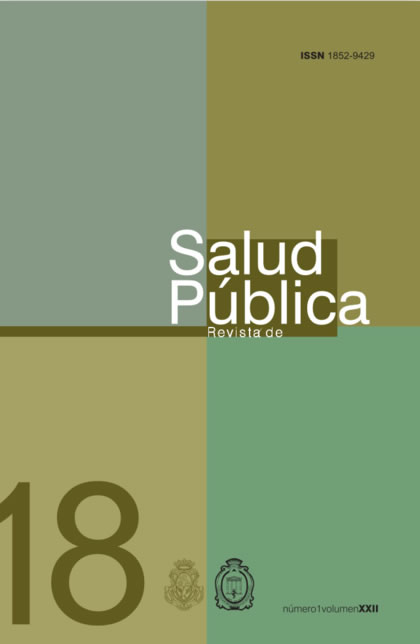SHORT COMMUNICATION MATHEMATIC MODELING OF THE DISTRIBUTION OF VOC´S IN THE AIR OF THE CITY OF CORDOBA, ARGENTINA
DOI:
https://doi.org/10.31052/1853.1180.v22.n1.19897Keywords:
Atmospheric pollution, Environment, Cordoba, VOCs, Inventory of Emissions, ArgentinaAbstract
At the end of the XX Century, the city of Cordoba had a monitoring net of atmospheric contaminants which were regularly used to measure NO2, SO2, CO, O3 and PM10. For certain atmospheric contaminants such as Volatile Organic Compounds (VOCs), existent information is not consistent or enough. This work starts from the need to have measurements of environment concentration of VOCs to assess health risk and take decisions regarding public and private policies, since they require information about levels of population exposure to contaminants, number of people exposed, length of exposition, and the knowledge of quantitative relationships between exposition and effects on health. In this communication, we start from the existent inventory of emissions of atmospheric contaminants from fixed and mobile sources in the city of Cordoba to proceed to the mathematic modeling of the distribution of concentration in the environmental table definer in order to make the inventory of emissions.
Downloads
References
Agency for Toxic Substances and Diseases Registry. Page last reviewed; March 3, 2011; Page last updated: March 3, 2011; Content source: Agency for Toxic Substances and Disease Registry. http://www.atsdr.cdc.gov/toxprofiles/tp13.html).
2. Agency for Toxic Substances and Diseases Registry. Toxicological Profile for Benzene. U.S. Department of Health and Human Services. August 2007. http://www.atsdr.cdc.gov/toxprofiles/tp3.pdf).
3. Agency for Toxic Substances and Diseases Registry. Toxicological Profile for Toluene. U.S. Department of Health and Human Services. September 2000. http://www.atsdr.cdc.gov/toxprofiles/tp56.pdf).
4. Agency for Toxic Substances and Diseases Registry. Toxicological Profile for Xylene. U.S. Department of Health and Human Services. August 2007. http://www.atsdr.cdc.gov/toxprofiles/tp71.pdf).
5. Buckley T. J., Payne-Sturges D., Kim S. R. and Weaver V. COV Exposures in an Industry-Impacted Community. NUATRC Research Report, Number 4. Baltimore:. Department of Environmental Health Sciences. Johns Hopkins Bloomberg School of Public Health. 2005.
6. Sbarato R. D. y Rubio M. 2017, Estimación de COV´s emitidos por fuentes fijas y móviles en el aire de la ciudad de Córdoba, Argentina. Comunicación Breve. Revista de la Escuela de Salud Pública, Facultad de Ciencias Médicas, Universidad Nacional de Córdoba. ACEPTADO PARA PUBLICACIÓN.
7. Alcaide López de la Manzanara M T. 2000. Efectos ambientales del tráfico urbano: la evaluación de la contaminación atmosférica en Madrid. Tesis Doctoral de Escuela Técnica Superior de Ingenieros de Montes. España: 358 p.
8. Sanín Cortés N. 2002. Construcción de un modelo tridimensional para ajuste de campos de viento y dispersión de contaminantes en la atmósfera. Tesis Doctoral de la Universidad de Las Palmas de Gran Canaria. España: 188 p.
9. Orozco Barrenetxea C, Pérez Serrano A, González Delgado MN, Rodríguez Vidal FJ & Alfayate Blanco JM. 2008. Contaminación Ambiental. Una visión desde la Química. Thomson Ed., Spain: 681 p.
10. Bustos Salas C. 2004. Aplicación de modelos de dispersión atmosférica en la evaluación de impacto ambiental: análisis del proceso. Tesis de Magister de la Universidad de Chile, Santiago, Chile: 86 p.
11. Henry J. G. and Heinke G.W. 1999. Ingeniería Ambiental. 2° Editorial Prentice Hall. México: 777 p.
2. Resolución 105 del Ministerio de Agua, Ambiente y Servicios Públicos. Boletín Oficial de la Provincia de Córdoba, año CIV - Tomo DCXXXI - Nº 128 Córdoba, (R.A.), martes 4 de julio de 2017. http://boletinoficial.cba.gov.ar/wp-content/4p96humuzp/2017/07/1_Secc_04072017.pdf.
13. SCREEN3 U.S.EPA, 2000. https://www.epa.gov/scram/air-quality-dispersionmodeling-screening-models.
14. Sbarato R D y colaboradores Metodologías de diagnóstico y pronóstico e contaminación atmosférica en ecosistemas urbanos. Córdoba: Ed. Universitaria; 2001. 276 p. ISBN:950-33-0285-4.
15. Sbarato R D, Ortega J E y Sbarato V. M. Contaminación del Aire.Córdoba: Encuentro, Grupo Editor; 2009. 124 p. ISBN
978-987-1432-36-3.
16. Consejo Superior del Investigaciones Científicas, Centro de Astrobiología, Gobierno de España, 2012. https://cab.inta-csic.es/uploads/culturacientifica/adjuntos/20130121115330.pdf.
Downloads
Published
Issue
Section
License
Copyright (c) 2018 Escuela de Salud Pública y Ambiente. Facultad de Ciencias Médicas. Universidad Nacional de Córdoba

This work is licensed under a Creative Commons Attribution-NonCommercial 4.0 International License.
Authors who have publications with this journal agree to the following terms:
The generation of derivative works is permitted as long as it is not done for commercial purposes.
The original work may not be used for commercial purposes.
Authors are allowed and encouraged to disseminate their work through professional social networks or on their website, after the publication process, in order to increase the visibility of their research.







